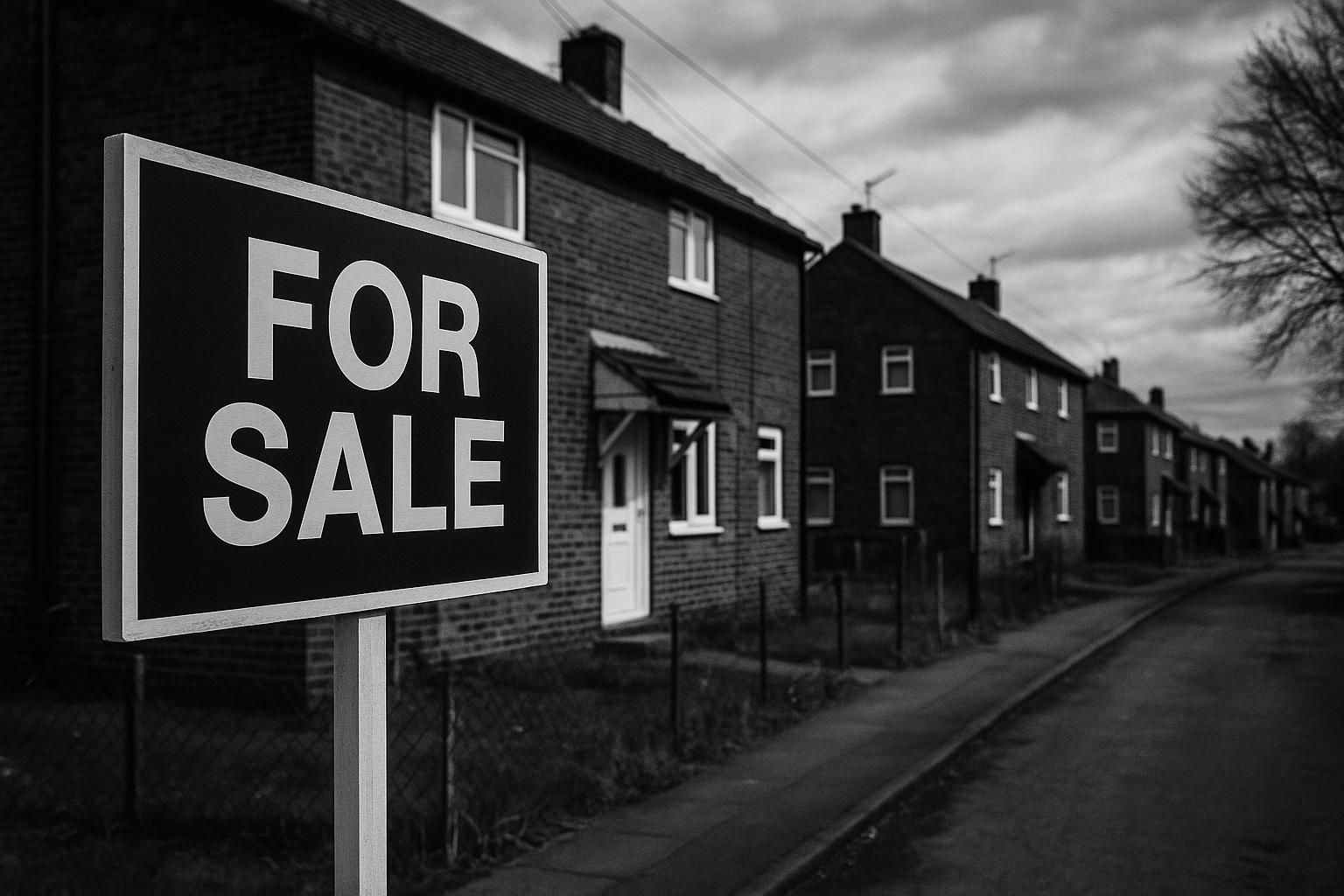New data reveals a sharp decline in small buy-to-let landlords selling more rental homes than they purchase, driving rental shortages across suburban UK. Institutional investors are stepping in to fill the gap, signalling a transformative shift in ownership and rental housing supply.
New data reveals a significant and accelerating exodus of small landlords from the UK’s buy-to-let (BTL) market, intensifying rental property shortages across suburban areas and beyond. According to a recent Savills report, the number of homes available to rent in suburban locations remains 31% lower than in 2018/19, underscoring a persistent decline that has gathered pace in recent years. Analysis of HM Land Registry figures indicates that in 2024 landlords sold 5.4 homes to owner-occupiers for every rental property they purchased, a sharp reversal from an approximate 1:1 ratio in 2021 and a clear sign of exit from the buy-to-let market by smaller individual landlords.
The Savills research identifies a consolidation trend within the private rental sector, where landlords with larger property portfolios are growing their share of rental homes while smaller landlords step back. Between 2018 and 2024, landlords owning five to 24 homes increased their market share from 33.0% to 35.4%, adding roughly 150,000 properties. Mortgage statistics reveal the average number of properties per mortgaged landlord rose from 3.2 in 2018 to 4.5 in 2024. This shift is driven in no small part by demographics: the median landlord age is 59, with over half having been landlords for more than a decade. Many view their properties as long-term pension investments, now realising capital gains as retirement approaches.
This decline of small-scale buy-to-let landlords is reflected in urban centres such as London, where 22% of sales of previously rented homes in July 2024 were concentrated in inner London—a notable increase reflecting struggles with lower yields, higher costs, and looming regulations like the introduction of minimum emissions standards for rental properties by 2030. Plummeting buy-to-let mortgage lending and planned reforms—such as new renter protections and restrictions on no-fault evictions—have further dampened landlord enthusiasm. The overall effect has been a tightening of supply, spiking rents substantially. Rents surged by up to 12.2% in the year following the pandemic’s peak demand, albeit with growth softening recently due to market pressures.
Financial and regulatory factors have also accelerated sales beyond small landlords. Over the past six years, buy-to-let and second home sales have increased by 34%, comprising one-sixth of all property disposals. Factors include amplified stamp duty charges, reduced mortgage interest tax relief, potential new taxation on capital gains, and fears over further regulation should a Labour government implement stricter rent controls and tax alignment. The heightened uncertainty has pushed many landlords, particularly in London and the South East, to offload properties ahead of anticipated tax hikes and regulatory change.
In response to shrinking individual landlord participation and rising demand, institutional investment in rental housing is increasing notably. Major investors such as Aviva, Legal & General, and others are significantly ramping up commitments to the build-to-rent (BTR) sector. Over the past decade, the BTR sector has delivered 130,000 new rental homes, but this remains insufficient to fully counterbalance sales from smaller landlords. These large-scale investors view the sector as an opportunity for stable, long-term returns and are focused on providing higher-quality, sustainable housing. Supporting this, local authorities are being encouraged to back rental housing development within their planning frameworks to help stem the rental shortage.
The shift towards institutional landlords marks a deeper transition in the rental market’s structure. In countries like Germany and the USA, over a third of rental housing is owned and managed by institutions—a model UK experts predict may become more prevalent. Industry leaders highlight the importance of this trend to enhance supply and improve quality, especially in suburban markets where rental shortages are most acute. While BTR developments tend to focus on scale and modern amenities, there remains a critical need to ensure that the rental sector remains accessible and diverse in price points for a broad range of tenants.
Meanwhile, renters—especially those aged over 35—face ongoing challenges. Many are caught in an affordability squeeze and tenancy instability that small and large landlords alike struggle to alleviate. Although institutional landlords and BTR schemes are introducing longer-term leases and better tenant protections, the overall rental environment still lacks adequate legal safeguards, contributing to ongoing insecurity. This is particularly evident in high-cost areas like London, where the super-prime rental market has also expanded rapidly, catering to affluent renters seeking flexibility and top-tier amenities. These luxury rentals have grown in popularity among wealthy professional and international tenants attracted by lifestyle factors and rising taxation complexity for homeowners.
In sum, the UK’s private rental market is undergoing a profound transformation. The traditional buy-to-let landlord is retreating under financial and regulatory pressures, replaced increasingly by institutional investors and large-scale professional landlords. While this shift promises benefits of greater supply and rental stability in some areas, it also raises pressing questions about affordability, tenant protections, and the future shape of private rented housing in the UK. Addressing these challenges requires coordinated efforts between investors, policymakers, and local authorities to ensure the rental market supports the diverse needs of Britain’s growing tenant population.
 Reference Map:
Reference Map:
- Paragraph 1 – [1], [2]
- Paragraph 2 – [1]
- Paragraph 3 – [2], [3]
- Paragraph 4 – [3], [5], [1]
- Paragraph 5 – [1], [5]
- Paragraph 6 – [1], [6]
- Paragraph 7 – [4], [6]
- Paragraph 8 – [1], [5], [6]
Source: Noah Wire Services
- https://www.landlordtoday.co.uk/breaking-news/2025/07/were-off-new-evidence-of-massive-exodus-of-landlords-from-buy-to-let/ – Please view link – unable to able to access data
- https://www.ft.com/content/0180e4a1-618f-4b6a-a05b-bda25b9694a1 – An increasing number of buy-to-let properties in London are being sold, reducing the availability of rental homes. In July 2024, 22% of properties previously rented and now for sale were in inner London, up from previous years. Factors include lower yields, tax changes, and upcoming regulations like minimum emissions ratings for rentals by 2030. Slower house price increases and higher mortgage costs have also impacted profits, prompting landlords to sell. Planned rental reforms, such as protections against rent increases and the removal of no-fault evictions, further influence the market. The number of buy-to-let mortgage loans has dropped significantly, and the scarcity of rental properties has driven up rents, though the rate of rent growth has softened recently.
- https://www.ft.com/content/b3bd48f1-3477-4980-8c44-6de4b0ee1fd4 – Sales of buy-to-let properties and second homes in Britain have increased by 34% over the past six years due to financial and regulatory pressures on landlords. Savills’ analysis reveals that annual sales of such properties rose from an average of 129,000 to 190,000 in recent years, now accounting for one in six property disposals. Increased stamp duty, loss of higher-rate tax relief on mortgage interest, and potential abolition of ‘no-fault’ evictions contribute to this trend. Landlords are concerned about potential tax increases if Labour comes into power, leading many to sell properties ahead of time. Concentrated in London and the southeast, these sales are influenced by high mortgage costs and potential capital gains tax (CGT) reforms. Labour’s potential CGT alignment with income tax could significantly impact landlords’ tax bills, further driving sales under current rates. Savills highlights the urgency for landlords to act before the proposed Budget on October 30.
- https://www.ft.com/content/481e49c5-5e04-45cf-8f73-abd40c043d41 – Renting top-tier properties in London is becoming increasingly popular among affluent residents, driven by several factors including changing inheritance rules, high stamp duty taxes, and the benefits of flexibility and convenience. The number of super-prime rentals (costing at least £5,000 per week) has risen significantly, with a broader range of exclusive apartments and townhouses available. Popular areas include Knightsbridge, Notting Hill, and Hampstead. Wealthy renters appreciate top amenities and services, and many prefer to rent to avoid the complexities of buying property and to maintain liquidity. Americans are a dominant group in this market, attracted by London’s culture, education, and strategic timezone. The rise in super-prime rentals is also influenced by the new Foreign Income and Gains regime and higher rental yields compared to period homes. The trend is toward both short-term and long-term leases, reflecting a desire for flexibility and security in rental agreements.
- https://www.reuters.com/world/uk/major-investors-pile-uk-rental-homes-despite-regulatory-fears-2024-07-12/ – Despite concerns over potential stricter rental regulations from the new Labour government, major investors like Aviva, Legal & General, M&G, and Royal London Asset Management are significantly increasing their investments in the UK rental housing market. Aviva alone has invested £750 million in the last 18 months and aims to triple this in three to four years. The demand for rental homes continues to surpass supply, making this sector attractive despite regulatory uncertainties and high interest rates. Foreign investors, including PGIM and Blackstone, are also entering the market, motivated by long-term returns and supported by government pledges to boost housing development. However, investors are cautious about proposed renter protection legislation, particularly rent controls, which could deter investment. Campaigners argue that rent controls are necessary to address inflation and wage stagnation issues. Overall, the residential rental sector remains a preferred investment avenue for European real estate funds, driven by a significant increase in portfolio allocations in the last decade.
- https://www.ft.com/content/93fd5258-8648-49ed-b76f-44dace53df0d – Irene, a middle-aged film production worker, has faced instability in London’s rental market for decades and has been priced out of homeownership. This issue reflects a broader trend in the UK, where over 35s, who now make up a significant portion of renters, struggle with affordability and stability in the private rental sector. Corporate landlords and the growing build-to-rent sector are stepping in to address this demographic by offering more stable, long-term tenancies and targeting investments towards this expanding market. However, the UK rental market still lacks sufficient legal protections for tenants, contributing to ongoing instability and high costs. Renters also face pressure from rising rents and limited housing supply, creating an urgent need for regional housing strategies and legislative reforms to improve tenant conditions and affordability.
Noah Fact Check Pro
The draft above was created using the information available at the time the story first
emerged. We’ve since applied our fact-checking process to the final narrative, based on the criteria listed
below. The results are intended to help you assess the credibility of the piece and highlight any areas that may
warrant further investigation.
Freshness check
Score:
8
Notes:
The narrative presents recent data from a Savills survey dated 3rd July 2025, indicating a significant exodus of small landlords from the UK’s buy-to-let market. This aligns with earlier reports from February 2025, which highlighted a similar trend. The inclusion of updated statistics and references to recent legislative changes, such as the Renters’ Rights Bill, suggests an effort to provide fresh insights. However, the core theme of landlords exiting the market has been previously reported, indicating a degree of recycled content. The report appears to be based on a press release, which typically warrants a higher freshness score. Nonetheless, the repetition of the same narrative across multiple outlets may reduce the perceived novelty.
Quotes check
Score:
7
Notes:
The narrative includes direct quotes from the Savills survey and references to the Renters’ Rights Bill. These quotes are consistent with information available in earlier reports from February 2025. The wording of the quotes varies slightly across sources, but the core information remains unchanged. No new, exclusive quotes are presented, suggesting that the content may be recycled.
Source reliability
Score:
6
Notes:
The narrative originates from Landlord Today, a publication focused on landlord and property news. While it provides references to reputable sources like Savills and HM Land Registry, the publication itself is not widely recognised as a primary news source. The reliance on a press release from Savills and the lack of independent verification raise questions about the reliability of the information presented.
Plausability check
Score:
8
Notes:
The claims regarding the exodus of small landlords from the buy-to-let market are plausible and align with trends observed in earlier reports. The narrative cites specific statistics, such as the 5:1 ratio of homes sold by landlords to owner-occupiers in 2024, which is consistent with data from February 2025. The discussion of legislative changes, including the Renters’ Rights Bill, adds context to the situation. However, the lack of new, corroborating sources or independent verification of the data diminishes the overall credibility.
Overall assessment
Verdict (FAIL, OPEN, PASS): FAIL
Confidence (LOW, MEDIUM, HIGH): MEDIUM
Summary:
The narrative presents recycled content with updated statistics and references to recent legislative changes. The reliance on a press release and the lack of independent verification raise concerns about the freshness and reliability of the information. The absence of new, exclusive quotes and the repetition of the same narrative across multiple outlets further diminish the credibility of the report.













